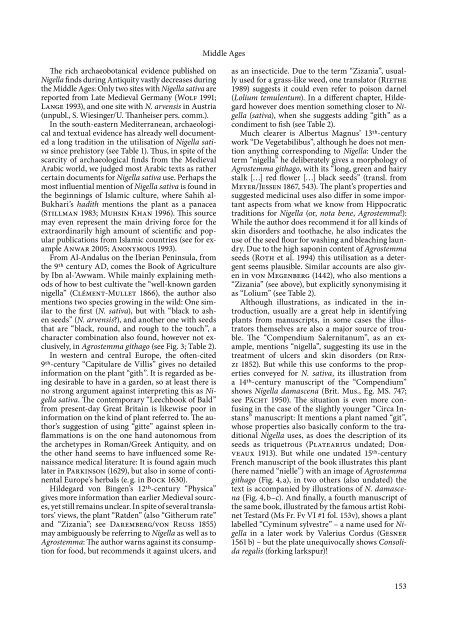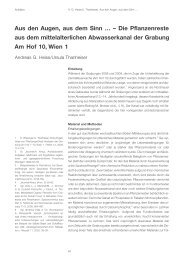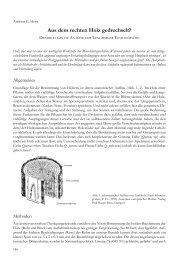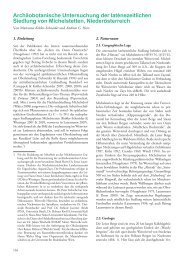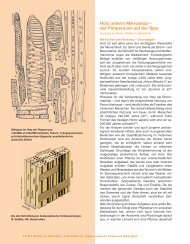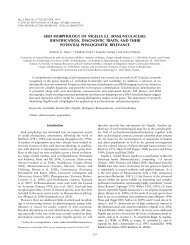View - erbsenzaehler.at
View - erbsenzaehler.at
View - erbsenzaehler.at
You also want an ePaper? Increase the reach of your titles
YUMPU automatically turns print PDFs into web optimized ePapers that Google loves.
Middle Ages<br />
The rich archaeobotanical evidence published on<br />
Nigella finds during Antiquity vastly decreases during<br />
the Middle Ages: Only two sites with Nigella s<strong>at</strong>iva are<br />
reported from L<strong>at</strong>e Medieval Germany (Wolf 1991;<br />
Lange 1993), and one site with N. arvensis in Austria<br />
(unpubl., S. Wiesinger/U. Thanheiser pers. comm.).<br />
In the south-eastern Mediterranean, archaeological<br />
and textual evidence has already well documented<br />
a long tradition in the utilis<strong>at</strong>ion of Nigella s<strong>at</strong>iva<br />
since prehistory (see Table 1). Thus, in spite of the<br />
scarcity of archaeological finds from the Medieval<br />
Arabic world, we judged most Arabic texts as r<strong>at</strong>her<br />
certain documents for Nigella s<strong>at</strong>iva use. Perhaps the<br />
most influential mention of Nigella s<strong>at</strong>iva is found in<br />
the beginnings of Islamic culture, where Sahih al-<br />
Bukhari’s hadith mentions the plant as a panacea<br />
(Stillman 1983; Muhsin Khan 1996). This source<br />
may even represent the main driving force for the<br />
extraordinarily high amount of scientific and popular<br />
public<strong>at</strong>ions from Islamic countries (see for example<br />
Anwar 2005; Anonymous 1993).<br />
From Al-Andalus on the Iberian Peninsula, from<br />
the 9th century AD, comes the Book of Agriculture<br />
by Ibn al-’Awwam. While mainly explaining methods<br />
of how to best cultiv<strong>at</strong>e the “well-known garden<br />
nigella” (Clément-Mullet 1866), the author also<br />
mentions two species growing in the wild: One similar<br />
to the first (N. s<strong>at</strong>iva), but with “black to ashen<br />
seeds” (N. arvensis?), and another one with seeds<br />
th<strong>at</strong> are “black, round, and rough to the touch”, a<br />
character combin<strong>at</strong>ion also found, however not exclusively,<br />
in Agrostemma githago (see Fig. 3; Table 2).<br />
In western and central Europe, the often-cited<br />
9th-century “Capitulare de Villis” gives no detailed<br />
inform<strong>at</strong>ion on the plant “gith”. It is regarded as being<br />
desirable to have in a garden, so <strong>at</strong> least there is<br />
no strong argument against interpreting this as Nigella<br />
s<strong>at</strong>iva. The contemporary “Leechbook of Bald”<br />
from present-day Gre<strong>at</strong> Britain is likewise poor in<br />
inform<strong>at</strong>ion on the kind of plant referred to. The author’s<br />
suggestion of using “gitte” against spleen inflamm<strong>at</strong>ions<br />
is on the one hand autonomous from<br />
the archetypes in Roman/Greek Antiquity, and on<br />
the other hand seems to have influenced some Renaissance<br />
medical liter<strong>at</strong>ure: It is found again much<br />
l<strong>at</strong>er in Parkinson (1629), but also in some of continental<br />
Europe’s herbals (e. g. in Bock 1630).<br />
Hildegard von Bingen’s 12th-century “Physica”<br />
gives more inform<strong>at</strong>ion than earlier Medieval sources,<br />
yet still remains unclear. In spite of several transl<strong>at</strong>ors’<br />
views, the plant “R<strong>at</strong>den” (also “Githerum r<strong>at</strong>e”<br />
and “Zizania”; see Daremberg/von Reuss 1855)<br />
may ambiguously be referring to Nigella as well as to<br />
Agrostemma: The author warns against its consumption<br />
for food, but recommends it against ulcers, and<br />
as an insecticide. Due to the term “Zizania”, usually<br />
used for a grass-like weed, one transl<strong>at</strong>or (Riethe<br />
1989) suggests it could even refer to poison darnel<br />
(Lolium temulentum). In a different chapter, Hildegard<br />
however does mention something closer to Nigella<br />
(s<strong>at</strong>iva), when she suggests adding “gith” as a<br />
condiment to fish (see Table 2).<br />
Much clearer is Albertus Magnus’ 13th-century<br />
work “De Vegetabilibus”, although he does not mention<br />
anything corresponding to Nigella: Under the<br />
term “nigella” he deliber<strong>at</strong>ely gives a morphology of<br />
Agrostemma githago, with its “long, green and hairy<br />
stalk […] red flower […] black seeds” (transl. from<br />
Meyer/Jessen 1867, 543). The plant’s properties and<br />
suggested medicinal uses also differ in some important<br />
aspects from wh<strong>at</strong> we know from Hippocr<strong>at</strong>ic<br />
traditions for Nigella (or, nota bene, Agrostemma!):<br />
While the author does recommend it for all kinds of<br />
skin disorders and toothache, he also indic<strong>at</strong>es the<br />
use of the seed flour for washing and bleaching laundry.<br />
Due to the high saponin content of Agrostemma<br />
seeds (Roth et al. 1994) this utilis<strong>at</strong>ion as a detergent<br />
seems plausible. Similar accounts are also given<br />
in von Megenberg (1442), who also mentions a<br />
“Zizania” (see above), but explicitly synonymising it<br />
as “Lolium” (see Table 2).<br />
Although illustr<strong>at</strong>ions, as indic<strong>at</strong>ed in the introduction,<br />
usually are a gre<strong>at</strong> help in identifying<br />
plants from manuscripts, in some cases the illustr<strong>at</strong>ors<br />
themselves are also a major source of trouble.<br />
The “Compendium Salernitanum”, as an example,<br />
mentions “nigella”, suggesting its use in the<br />
tre<strong>at</strong>ment of ulcers and skin disorders (de Renzi<br />
1852). But while this use conforms to the properties<br />
conveyed for N. s<strong>at</strong>iva, its illustr<strong>at</strong>ion from<br />
a 14th-century manuscript of the “Compendium”<br />
shows Nigella damascena (Brit. Mus., Eg. MS. 747;<br />
see Pächt 1950). The situ<strong>at</strong>ion is even more confusing<br />
in the case of the slightly younger “Circa Instans”<br />
manu script: It mentions a plant named “git”,<br />
whose properties also basically conform to the traditional<br />
Nigella uses, as does the description of its<br />
seeds as triquetrous (Pl<strong>at</strong>earius und<strong>at</strong>ed; Dorveaux<br />
1913). But while one und<strong>at</strong>ed 15th-century<br />
French manuscript of the book illustr<strong>at</strong>es this plant<br />
(here named “nielle”) with an image of Agrostemma<br />
githago (Fig. 4, a), in two others (also und<strong>at</strong>ed) the<br />
text is accompanied by illustr<strong>at</strong>ions of N. damascena<br />
(Fig. 4, b–c). And finally, a fourth manuscript of<br />
the same book, illustr<strong>at</strong>ed by the famous artist Robinet<br />
Testard (Ms Fr. Fv VI #1 fol. 153v), shows a plant<br />
labelled “Cyminum sylvestre” – a name used for Nigella<br />
in a l<strong>at</strong>er work by Valerius Cordus (Gesner<br />
1561 b) – but the pl<strong>at</strong>e unequivocally shows Consolida<br />
regalis (forking larkspur)!<br />
153


